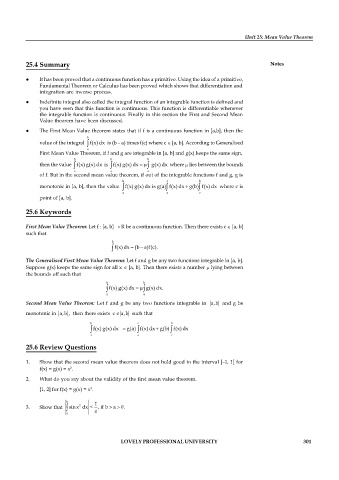Page 307 - DMTH401_REAL ANALYSIS
P. 307
Unit 25: Mean Value Theorem
25.4 Summary Notes
It has been proved that a continuous function has a primitive. Using the idea of a primitive,
Fundamental Theorem or Calculus has been proved which shows that differentiation and
integration are inverse process.
Indefinite integral also called the integral function of an integrable function is defined and
you have seen that this function is continuous. This function is differentiable whenever
the integrable function is continuous. Finally in this section the First and Second Mean
Value theorem have been discussed.
The First Mean Value theorem states that if f is a continuous function in [a,b], then the
b
value of the integral f(x) dx is (b – a) times f(c) where c [a, b]. According to Generalised
ò
a
First Mean Value Theorem, if f and g are integrable in [a, b] and g(x) keeps the same sign,
h b b
then the value f(x) g(x).dx is f(x) g(x) dx = ò g(x) dx where lies between the bounds
ò
ò
a a a
of f. But in the second mean value theorem, if out of the integrable functions f and g, g is
h c b
ò
ò
monotonic in [a, b], then the value f(x) g(x) dx is g(a) f(x) dx g(b) f(x) dx+ ò where c is
a a c
point of [a, b].
25.6 Keywords
First Mean Value Theorem: Let f : [a, b] R be a continuous function. Then there exists c [a, b]
such that
b
-
ò f(x) dx = (b a)f(c).
The Generalised First Mean Value Theorem: Let f and g be any two functions integrable in [a, b].
Suppose g(x) keeps the same sign for all x [a, b]. Then there exists a number lying between
the bounds off such that
b b
ò f(x) g(x) dx = ò g(x) dx.
a a
Second Mean Value Theorem: Let f and g be any two functions integrable in a,b and g be
monotonic in a,b , then there exists c a,b such that
b c b
+
ò
ò f(x) g(x) dx = g(a) f(x) dx g(b) f(x) dx
ò
a a c
25.6 Review Questions
1. Show that the second mean value theorem does not hold good in the interval [–1, 1] for
f(x) = g(x) = x .
2
2. What do you say about the validity of the first mean value theorem.
3
{1, 2] for f(x) = g(x) = x .
b 1
2
ò
a
3. Show that sinx dx £ , if b > > 0.
a a
LOVELY PROFESSIONAL UNIVERSITY 301

